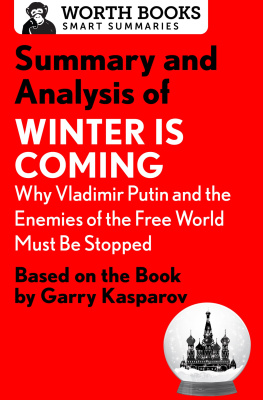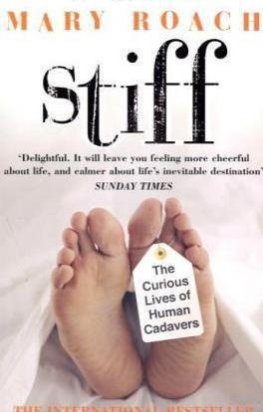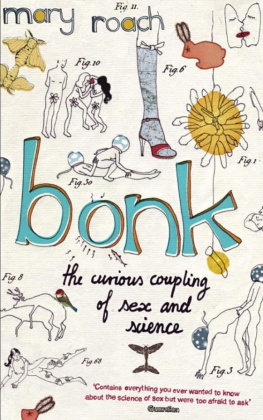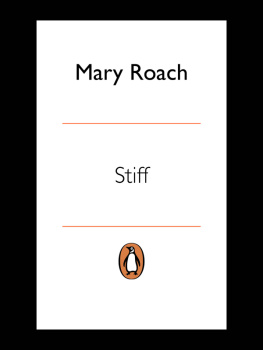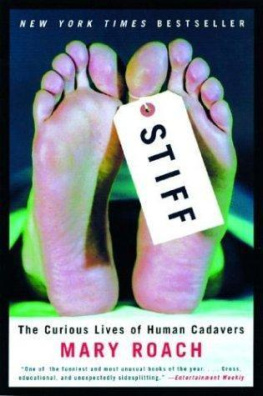Summary and Analysis of
Stiff
The Curious Lives of Human Cadavers
Based on the Book by Mary Roach

Contents
Context
As science writer, Mary Roachs interest in cadavers was entirely self-motivated, she explains in the introduction to Stiff . In 2003, at the time of the books publication, there was not a detectable uptick in national interest in cadavers and/or dead bodies. (Or if there was, Roach did not seem to be aware of it.) However, the early 2000s was arguably the twilight of the golden era of magazine journalism. The Internet news revolution had not yet taken over print, and dozens of highly regarded national magazines were paying good money for deep dives into fascinating topics. And though humans have always been fascinated by death, popular shows such as Six Feet Under and CSI have brought the conversation of examining them to the fore.
Hard-working journalist Mary Roach, with bylines from the likes of Wired , the New York Times , and Outside , had the funding andthe opportunity to pursue her fascinations and build up her name. Her curiousoutsiders take on a largely unknown and seemingly strange topic resonated with thepublic, and Stiff became an instant bestseller andaward winner. Roach replicated her winning technique in her subsequent books, mostof which are dedicated to investigating lesser-known frontiers of science, including Gulp: Adventures on the Alimentary Canal . Herwriting style, which is accessible, informative, and uncomplicated, expanded thereach of the popular-science genre, demonstrated by the numerous young adult awardsthat Stiff received in 2003 and 2004.
In a 2016 profile of Roach that seemed to sum up her influence, a writer for the Everett Herald newspaper notes that the author calls her best-selling books a gateway drug for science. Accordingly, it is not surprising that Stiff has come to be a popular inclusion on high school summer reading lists.
Overview
A Head Is a Terrible Thing to Waste declares the first chapter title of Stiff , Mary Roachs first-person account of the world of human cadavers. Equal parts morbid and cheeky, the title (an allusion to the iconic slogan of the United Negro College Fund) offers a representative sample of the books subject matter and Roachs attitude toward it. She is not intimidated by death, even if it is one of the least popular cocktail-party topics. Rather, she finds it fascinating and often very funny. We are all going to die, as the saying goes, and pretending or wishing things were otherwise is not going to save us.
Learning about the bizarre, creepy, smelly, mushy, and occasionally comical things that will happen to our bodies after we permanently depart, however, may make us less afraid of our fateor at least provide an informative and entertaining distraction from the truth that our earthly existence is precarious and short.
Stiff kicks off with Roachs visit to a dissection lab at an unnamed medical school. While she looks on, a group of plastic surgeons practice their skills by giving face-lifts to human heads. It is a jolting introduction, but one that sets the tone for all of Roachs eye-opening (and sometimes stomach-churning) adventures in the book. In her quest to follow the lives of cadavers, she finds herself in situations unimaginable to anyone except for medical professionals, researchers, or particularly creative serial killers.
Despite its graphic content, Stiff is much more than a romp through various kinds of grotesquerie. A seasoned reporter, Roach has done her research, and the book is a chronicle of historical and modern uses of cadavers. Each chapter is organized around a different topic, and in each section, Roach interjects her first-person explorations with historical background. As a result, the reader comes away horrified, puzzled, entertained, and educated.
Roach also touches on the complicated and sometimes controversial questions that surround the use of cadavers. Would you mind if your cousins expired body was blown up to test landmine removal safety equipment? Would it bother you if your fathers remains were crashed into a brick wall at 80 miles per hour? Should we allow the use of child cadavers if they can provide critical information that might save lives of others? Answers to these questions, like so much related to death, depend on our values, social norms, anxieties, and religious beliefs. With its curious and sympathetic investigations, Stiff is likely to challenge many preconceptions about death.
Ultimately, Stiff can be seen as a series of very strange profiles in courage. Impact test cadavers, ballistics test cadavers, decomposing murder victimsimulating cadavers, and otherseach of them provides critical information that can be used to make cars safer, body armor stronger, and crime-scene forensics more accurate. Dead bodies are shot, mutilated, blown up, left to rot, and otherwise woefully mistreated (mostly) for benevolent purposes. Cadavers are our superheroes, asserts Roach in the introduction, with no small amount of admiration for these fearless self-sacrificers who never complain.
Summary
Introduction
In this opening section, author Mary Roach explains a little about herself and why she decided to dedicate an entire book to a topic that people usually consider tabooif they choose to think about it at all. After years of reporting from the far ends of the Earth as a travel journalist, Roach realized that lesser-explored areas of science could be just as fascinating and intimate. She points out that society owes a huge debt to cadavers, which are shot, cut, dropped off buildings, and otherwise disfigured in all sorts of creative ways so that science may be advanced and human life may be improved.
In this section, Roach hints at the books narrative style, a combination of reporting and research with first-person commentary, in order to guide the reader through the subject at hand.
Need to Know: What happens to cadavers may make us squeamish, but it is also fascinating and important.
Chapter 1: A Head Is a Terrible Thing to Waste
Roach begins her journey by observing a face-lifting seminar at an unnamed southern university medical center. A group of plastic surgeons have paid $500 each to perform face-lifts on human heads. Roach finds it a bit distasteful that cadavers (which are in short supply) are being used for purposes of vanity, but she concedes that the more training surgeons haveeven plastic surgeonsthe better off their patients will be.
In fact, most surgeons first operating experiences are on living humans, which has no small number of drawbacks for the patient. There is a growing movement, however, to get more surgical residents operating on cadavers so that by the time they touch living human flesh, they already have some experience cutting bodies.
Need to Know: When Roach first enters the seminar and observes a group of forty human heads sitting on a table, she is taken aback by the grisly scene. She eventually concludes that the setup serves a noble purpose. Literal hands-on experience is invaluable to surgeons, no matter their operating specialty. The more opportunities they have to work with cadavers, the better their outcomes will be when they take their scalpels to living humans.
Chapter 2: Crimes of Anatomy
In her next stop, Roach attends a memorial service for the cadavers at the University of California, San Francisco, Medical School. It is a somber affair that radiates respect and appreciation for the humans who sacrificed their bodies to help other people. This present-day story provides the setup for a dive into cadaver history, which is impressively sordid.





